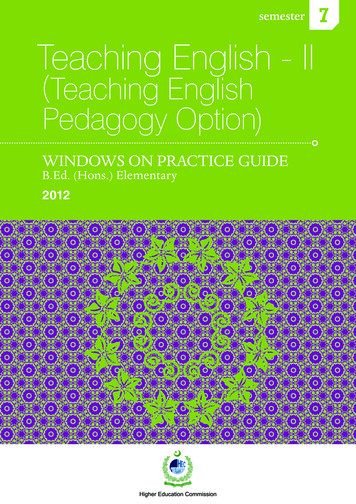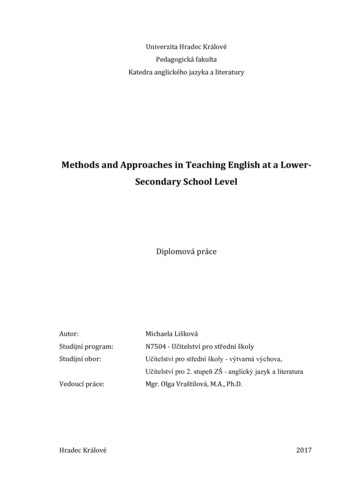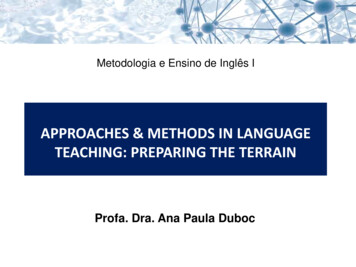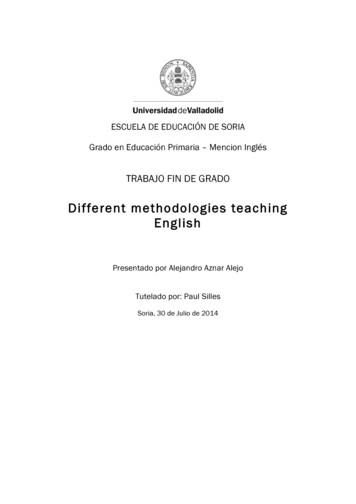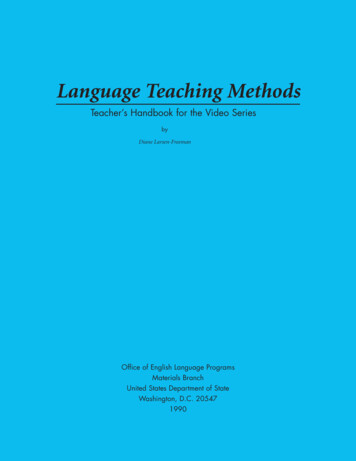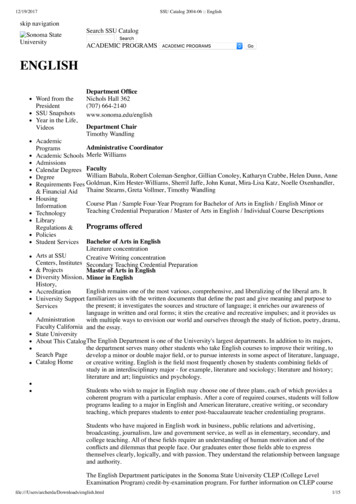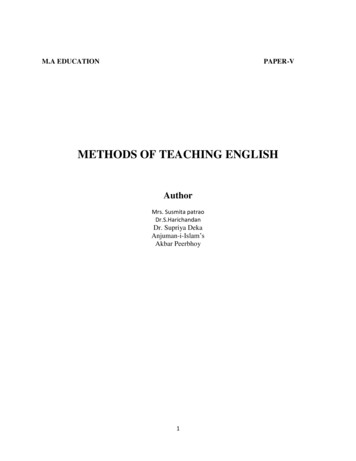
Transcription
M.A EDUCATIONPAPER-VMETHODS OF TEACHING ENGLISHAuthorMrs. Susmita patraoDr.S.HarichandanDr. Supriya DekaAnjuman-i-Islam’sAkbar Peerbhoy1
Method of Teaching EnglishUNIT-I(A) THE ROLE OF ENGLISH IN INDIA.THE PRESENT SITUATION.(B) THE OBJECTIVES OF TEACHING BOTH AT ELEMENTARY AND SECONDARYLEVELS.UNIT onHistorical Back ground of English in IndiaEnglish in post- Independent periodThe Three Language FormulaEnglish in 21st CenturyObjectives of teaching English1.6.1Objectives of teaching English at elementary level.1.6.2Objectives of teaching English at secondary level.1.0 ObjectivesAfter reading this unit you will be able to-State an historical account of the place of English in India.Understand the position of English in the post – independence period.Justify the place of English in Three Language formula.Explain the unique and very important place of English in 21st century.Discuss / analyses the objectives of teaching English at a second language(both at elementary as well as secondary level)1.1 IntroductionWhile studying this unit you should know why teaching of English becomeveryimportant in pre-independence period changes that took place in the position of English afterindependence and even when it was reduced to a lower status , still for all practical purposeshow it retained its supreme position in school curriculum even after six decades ofIndependence .1.2 Historical background of English in India.Indians came in contact with the English language since the establishment of East IndiaCompany in the year 1612. But the spread of the language took place when the British becamethe rules of this country. In 1813, English language was introduced as a medium of instructionat all the levels of education. Reformers like Rajaram Mohan Roy realized the importance ofEnglish and saw in it the promise of modernization and liberation. He Favored it. This opened2
the door for English in India. Lord Macaulay (1835) desired to produce through Englisheducation ‘’ a class of persons Indian in blood and colour but English in taste, in opinion, inmorals and in intellect’’.Hence the English language teaching situation during pre-independence period can be summedup as follows:a.b.c.d.English was dominating the school stage and even at the collegiate level.The teaching of English was largely pedantic, dull and largely wasteful.There was an emphatic on the formal grammar of written English.Pupil’s needs of English were severely limited. English was needed either for government jobswhich had a premium on formal written English or for going to a university where the teachingof literature was at the top. English for wider use like communication at the international levelor in the fields of commerce, engineering, technical, etc was non-existent those days.e. Consequently, the literary English was supreme in the teaching of English. The written Englishhad more prestige than the spoken form.f. There was an excessive dependence on the British model. There was a slavish imitation of themethods and techniques of teaching English in British schools.1.3 English in post- Independent period.Indian independence changed the status of English, but it did not affect the place of English inIndian life or education. English was no longer the language of rulers. But it continued to be thelanguage of elite.The constitution of India, adopted in 1950, had envisaged Hindi as the only official language ofthe union of India, while English was to continue for 15years. The was vehemently opposed bythe states in the south. As a result , English was adopted as the Associate Official language by anAct of parliament in 1963 and assurances have been given that it will continue to be linguafranca as long as the non-Hindi speaking people want it .1.4 The Three Language Formula :Even though English was accepted as Associate Official Language, it did not mean that it was tobe accepted as a medium of instruction in Indian schools. Mother tongue becomes the onlychoice as the medium of instruction. The psychological and social advantages of learning thoughone’s own mother-tongue had been proved by many researches in the field of Education. At thesame time the need was felt to learn more language. One for National Communication and theother for International Communication. This is how the three language formula emerged in theeducational field. The Three languages Formula is an attempt to address the challenges andopportunities of the linguistic situations in India. The primary aim of the formula is to promotemultilingualism and national harmony.3
The Three language formula states that every child in school has to read at least three language:(1) The regional language (2) Hindi and English in non- Hindi speaking areas (3) English andnon- Hindi regional language in Hindi speaking areas.The formula was presented by National Integration Council and later endorsed by Chief Minister‘Conference in 1961.Kothari Commission found some difficult lties in the working of this formulaand recommended in turn the Three language formula as follows :-(a) Mother tongue or regional language in class I to IV.(b) The official language of the union or the associate official language of the union so long as it isrecognized as such in classes V- VIII and(c) A Modern Indian or foreign language not covered under (a) and (b) in classes VIII-X.Mother tongue is thought to be the best medium of instruction as one can expressoneself with clarity, precision and vigor in thinking. Scientific and technical knowledge is alsomade available in mother tongue which facilitates development of the talent and the progress inlanguage. In Odisha, Odia is called L1, English L2, Hindi or Sanskrit L3. Now the teaching ofEnglish is started from the class III in Odisha board schools. This is not for belittling theimportance of mother tongue but for making Odia people efficient and fluent speakers inEnglish. That they should write English correctly is one of the objectives in starting English fromthe class III. That language should not become a barrier in the progress also another objective.1.5 English in 21st CenturyThough theoretically English is still the second language /third language, practically it is gainingimportance in every walk of life. In all the advanced states of India, more and more Englishmedium schools are being opened, people are inclined more to send their children to Englishmedium schools. Secondary education through mother tongue is looked down upon by not onlythe rich people but also by middle class people of India. International schools in India are thepopular choice among Indian parents.This shift of English has the following reasons.1. With the spread of information technology every type of advanced knowledge is stored onlyin English.2. All software for multiple functions in education, trade, commerce and industry is availableonly in the English language.3. With the growing trend of globalization in trade and industry, knowledge of English alongwith computer literacy has become a necessity for employment and better job opportunities.4
4. Due to the advent of foreign university, with their attractive courses and weight age which isgiven to the degrees of foreign university in the job market, importance of English has increasedmore than ever before.5. Introduction of computer games and computer aided instruction, right from first standard areavailable in English medium schools. Hence more and more parents are attracted towardsEnglish medium schools. As a result majority of the children from middle class also learn inthese schools and use English as their first language.6. At college and university level also courses like B.C.S , M.C.S , M.C.A , M.C.M, ComputerEngineering , M.B.A Computer, e- Commerce are in great demand Medium of instruction for allthese courses is English.Hence status of English is enhancing day by day. There is Englishization as well as nativisationof the language itself .( Englishization – the impact of English on local languages .Nativisation –the impact of local language on English)1.6 Objectives of teaching English.We know it very well that teaching of any subject is a social and culturalactivity. It is not so easy to teach any subject as it appears while teaching, a teacher has to keepin mind the aims and objectives of his subject. In other words we can say that teaching of anysubject becomes much effective when the teacher is fully conscious of the aims and objectives ofteaching of that subject. A good teacher thinks that his teaching should be effective. All of usknow it very well that the basic principle of teaching is “know what you do and only do whatyou know “. Teaching requires certain directions. After all, success of teaching depends on theaims and objectives of teaching.In teaching of English P.Gurrey writes “It is highly desirable to knowexactly what one is hoping to achieve. If this can be clearly seen, then the best way of getting towork us ually becomes evident. We ought, therefore, to consider carefully what we are trying todo when we are teaching English.Indian people consider English as a second language. It is not the medium ofinstruction for a majority of the students. It is an instrument, a means for acquiring knowledge.The aim of teaching English in India is to help students to acquire practical command of English.In other words, It means that students should be able to understand speak English, read and writeEnglish.The National Curriculum framework level.(NCF 2005) guided that the goals for second language curriculum are twofold.5
(a) Attainment of a basic proficiency such as is required in natural language learning.(b) The development of language in to an instrument for abstract thought.The teacher should keep in mind the aims of teaching English. The teachershould always emphasize on the aims of teaching of English. It will help to teach effectively.These objectives are to be set in line with the objectives mentioned in the syllabus guidelines ofNational curriculum framework (NCF 2005)Objectives are delineated at two levels. (i) At elementary level and(ii) At secondary level.1.6.1 Objectives of teaching English at Elementary level. Skill based subject , Hence at theElementary level the objective of teaching English should be to develop all the fourfundamental skills among them ie-LSRW- Listening- Speaking- Reading and- WritingThis can be done by familiarizing the child with the spoken language by exposing them to thelanguage in meaningful, interesting and real life situations through the mother tongue, signs,visuals, pictures, sketches, gestures, letters, words, single word questions and answers.Slowly the exposure to the language should move- to enable them to read and write, besideslistening and speaking.Hence the objectives of teaching English at Elementary level are to enable the students.-To listen English with proper understandingTo speak English correctly ieProducing sounds with proper stress and intonation.-To transform the silent written / printed language in to living speech.To enrich vocabulary through telling, re- telling, reading aloud.To read with easeTo follow the instructions given in the target language.To recite the small poems.To classify the words, nouns, action words (verb) , describing wordsadjectives, linkers (conjunctions ) etc.To write words simple meaningful sentences correctly.6
1.6.2 Objectives of teaching English at secondary level.Linguistics never differentiates between lower level and higher level objectives. Itthinks all its four objectives viz- Listening, Speaking, Reading and Writing (LSRW) are to berealized at both the levels. To these linguistic objectives, literature adds two more viz- Creativityand Appreciation. These two objectives are purely higher level.Linguistic and literary objectives are inter- linked with each other. They are not independent andinseparable from literature. It is true that literary objectives cannot be realised at the primarylevel. But we see that their seeds are sown in language teaching from elementary level that isfrom the very beginning.Thus along with the attainment of basic proficiencies the development of abstract thoughts,creativity and appreciation must be the objectives of teaching English at secondary level.An attempt is to be made to encourage the pupils in the two final years in a school to thusbegin appreciation of literary forms of the English writings and the cultural enjoyment of theEnglish language. The material thus presented should be suitably adapted to the needs of theircourse in a simple and suitable linguistic point of view.At the close of school career an average pupil should be able to:(i)Understand and follow talks in English on general topics within the prescribedvocabulary and sentence structures.(ii)Talk freely within the range of language items and express suitably.(iii) Read books and similar other material written in simplified English as per thestructures and vocabulary, and to follow easy books with detailed notes. This materialshould within their group.(iv)Write correctly in English on familiar topics fit to be expressed within the range ofthe prescribed vocabulary and sentence structures.(v)Write creatively and independently on general topics.(vi)Create wider reading interest.(vii) Speak in a given situation (production skill) (fluency & accuracy in speaking &writing)(viii) Develop study skill / reference skill.(ix)Achieve greater proficiency.These aims may also be described as reception and expression techniques. Reception meansunderstanding spoken and written matter in a language like English, while expression stands forspeaking and writing a language – English.7
The chart as below explains it clearly.AimsExpression (productive)Understanding (receptive)SpokenIn writingWrittenIn speechPassive CommandActive CommandIt can also be expressed with the following table / ngWriting
1.7 Let us sum up :While summing up this unit we would like to highlight some of the majorpoints which have been discussed here. The introductory part of this unit takesin to account the historical background of English in India. This also takes in toaccount the place of English in pre and post independent India and the threelanguage formula. It also throws light on the place of English in 21st Century.Further this unit tells us about the objectives of teaching English at Elementaryas well as secondary level.1.8 Unit end questions1. Discuss the place of English in pre and post Independent India.2. What is LSRW? Enumerate the specific objectives for LSRW.3. What are the aims and objectives of teaching English in India?4. What are the activities possible in our class room to develop the followingskills?(a). Listening and speaking(b). Reading(c)Writing1.9. References:1. Dr. H. K. Gurav Teaching Aspects of English language 20002. K. Venugopal Rao Methods of teaching English 20083. A. L. Kohli Techniques of Teaching English 20061.2.3.4.B W SomatkarJitendrasumarRama MeghanathanNCF 20059
UNIT – II The various methods and ApproachesOBJECTIVESThe students at the end the end of the unit would Know the meaning of the Grammar Translation Method Understand the working of the Grammar Translation Method Know the meaning of the Direct Method Understand the working of the Direct Method Know the meaning of the Structural Approach Understand the working of the Structural Approach Know the meaning of the Bilingual Method Understand the working of the Bilingual MethodGRAMMAR-CUM-TRANSLATION METHOD-Also called the Classical Method-Richards and Rogers (2002, 5) define it as: “A way of studying a language that approachesthe language first through detailed analysis of its grammar rules, followed by application ofthis knowledge through the task of translating sentences and text into and out of the targetlanguage.”Principles; Translation interprets foreign phraseology best. Interpretation helps better Assimilation. Structure of foreign language is best learnt when compared with the mother tongue. Grammar is the soul of language.Procedure:-Meaning of every word interpreted in the mother tongue.-Meanings of phrases/sentences clarified through translation.10
-Simultaneous explanation of grammar rules.-Vocabulary development.-Better understanding of context.-Based on ‘Apperceptive Theory’.-Textbook becomes the most important aid.-Develops the art & skill of translation.-Helps in testing Comprehension.Merits:Demerits:-No/less emphasis on Speaking, reading & Writing.-Expression?-Literal translation.-Habit of translation can inhibit thinking in Eng.-Quite artificial.-Not wholistic.-Dull & interesting.“Having done the translation . the pupil is almost far from the goal as ever.”- Moore.THE DIRECT METHODAlso called the Natural Method or the Reformed Method.“ To teach English directly is to establish a direct or immediate association between experience &expression; English word, phrase or idiom & meaning.” – H.Champion.Features: Translation banished. Grammar, when taught, taught inductively. Oral teaching precedes reading/writing. Meanings through objects/context.11
Principles: Establish a direct bond between word/phrase/idiom and meaning. More emphasis on listening and speaking. Less importance to mother tongue. Follows full sentences not words. Vocabulary is used directly. Grammar is ‘Grammar of use’ not ‘Grammar of rules’. Follows maxims- Simple to Complex; Concrete to Abstract. Pronunciation taught on phonetic lines. Questioning used more often.Merits:-Encourages thinking.-Enables expression.-Develops language sense.-Interesting.-Rote learning discouraged.-Develops language mastery.-Ample scope for activity, teaching aids.Demerits:-Does not work with higher classes.-Reading and writing sacrificed for speech.-Expensive.-Requires a small sized class.-Time consuming.THE STRUCTURAL APPROACHThis is the outcome of the efforts & researches done by the British Council in the Institute of education,Univ. of London.CONCEPT: Arrangement of words in such a way as to form a suitable pattern of sentences. Also known as ‘New Approach’ or ‘Aural-Oral Approach’.12
The Approach is a scientific study of the fundamental structures of the English language, theiranalysis & logical arrangement. – Brewington.Principles of Structural Approach:1) Speech is very important to fix these structure patterns or ground work in the mind of learner2) Activities of the learner are more significance, rather than those of the teacher.3) The student has to fix up habits of language patterns in English. He has to forget for the time being,patterns of his own language- the mother-tongue.4) The sentence patterns of English are to be picked up, practiced and fixed in mind.Structure:-Different arrangements or patterns of words.Types of Structures: Sentence pattern e.g. S V O. Phrase pattern ; e.g. Humpty Dumpty sat on the wall (Phrase ) Formulae; Use of common language such as “Good Morning”; “Thank you” Idioms; e.g. It was raining cats and dogs.Selection of Structure:The selection of any structure to be taught in a particular class should be based on the following adation.THE BILINGUAL METHODThe Bilingual method is mainly concerned with presentation and practice of language material. TheBilingual Method was first tried in Welsh [U.K.]. It was experimented upon at the Central Institute ofEnglish Language, Hyderabad Dr. Shastri who conducted the experiment, thinks that this method ishighly successful and provides adequate use in English in the class-room It tries to make the judicious useof mother-tongue for teaching English.13
Its principal features are as follows1) Using mother-tongue and English on a 1:1 basis. 1:1 ratio means the use of one mother-tongue word orsentence to one word or sentence of English. The teacher presents the new structure or word bytranslating it into mother-tongue and then using it in English.2) Instructions to repeat language item etc. are given in mother-tongue.3) Drills are given in English, but while testing, mother tongue is used at intervals.4) The teacher uses mother-tongue from the bilingual position to the monolingual position at the end.It is true that the method does give recognition to the fact that the second or third language learner knowshis mother tongue and this situation can be profitably used for teaching English. The method does notinhibit the use of mother tongue.TEST YOURSELF1. Explain the Meaning of the Grammar Translation Method.2. Explain the Meaning of the Direct Method3. Explain the Meaning of the Structural approach4. Explain the Meaning of the Bi lingual Method5. How is the Direct Method different from the Grammar Translation Method?6. How would a teacher use the Structural Approach in the teaching of English?14
Unit III: 1. Development of Reading SkillsAt the end of this unit you will be able to:a.b.c.d.e.f.Specify the nature of readingEnumerate the guidelines for beginning readingDescribe the characteristics of Fluent readingDistinguish between silent and loud readingCompare extensive and intensive forms of readingExplain the importance of supplementary readingA. The Mechanics of Reading3. A i. Nature of ReadingIn the context of language learning, reading means “reading and understanding”. The generalassumptions about the nature of reading are:1. We need to read and decode individual letters in order to read words particularly at theearly stages of reading. But if the context is clear, even partially illegible writing can beunderstood.2. We do not necessarily need to read every word accurately in order to understand a text.We need to read enough words to understand the main meanings of the text, and can skipor pay less attention to ones that repeat previous information or are redundant.3. If we understand all the words in a text, we are likely to understand the text, but we alsoneed to have some previous knowledge of the subject matter and text-type. When readinga text, we use information given by the words interacting with our own world knowledgein order to access the meaning.4. The more clearly the words are linked together to make coherent sense-units (phrases,sentences) and the more clearly sentences are linked together to make coherentparagraphs the easier the text will be to read.However, to begin reading the learners of English must be aware of phonemes. Many beginnerlearners of English have to learn a totally new writing system very different from their L1.It istherefore useful to work on phonemic awareness. Learners are encouraged to hear anddifferentiate between the different sounds or phonemes of English which they will need to matchwith the letters or letter combinations that represent them. For example, identifying thedifference between / p / and / b /, or between / i / and / i: /. Various kinds of oral exercises areused to enable learners to listen to sounds and do various identification tasks.15
Examples of tasks:Listen for the odd one out - / t / / t / / t / / d / / t /Which word rhymes with “patch” 1: Cash or 2. Catch?Is the / i: / sound at the beginning, middle, or end of the words: 1. Even 2. Three3. Steep?How many sounds can you locate in the word “man”?What word can be made by putting together the following sounds / m / / ae / / n /?3. A ii.Guidelines to beginning reading:1. It is preferable to begin reading only after acquiring some basic knowledge of the spokenlanguage. Reading thus becomes an exercise in recognizing meanings rather than justdecoding symbols.2. It is most practical to begin with single letters (the conventional phonic method), startingwith the most common and useful. The most common digraphs (two letter combinationsthat make a single sound like th, sh, ee) must be taught.3. It is helpful to teach learners how to pronounce the letter as it is read in a word and teachthe name later.4. Names of people, commercial products or places provide a lot of extra words that alearner can read and recognize.5. The conventional alphabetical order should also be taught.The ability to read and understand English is acquired mainly through later reading activity inwhich learners have the opportunity to engage repeatedly with written texts. For learners to startdeveloping reading fluency they need a lot of practice at the early stages in reading andunderstanding very short simple texts, at word and sentence level. The teacher can supplementthe course material with learning tasks ordered from the easiest to the most difficult using worksheets or work cards.Examples of Tasks:Letters in words: These exercises focus on single letters, wherein learners have to identify theletters in words which they already know in their spoken form.E.g. Under each picture is a set of letters. Cross out the letters that you can’t hear when you saythe word.16
A , B, F, P, E,O,LB, P, N, M, I, L, E,G,CP,B,U,O,C,KSingle words (cognates): Learners are asked to identify words that are likely to be the same orroughly similar in their own language. The purpose is to provide a wider range of vocabulary topractise reading.E.g. translate these words into your own language: summer, television, elephant, appleWrite out the names of the countries in your own language: England, Canada, Japan, and IndiaAre these names for boys or girls: Maria, Peter, David. Sarah, Anna?Single words (English words): The learners identify the words and demonstrate comprehension.E.g. Copy these words in the increasing order of size of the object: a bag, a tree, a mouseCircle the words that are the names of animals: head, dog, table, pencil, cow, horse.Which is the odd one out: run, walk, sit, jump?Phrases and short sentences:The learners need to understand whole sense – units and demonstrate understanding. This is thelast stage before beginning to read full texts.E.g. Draw the following items:a red ball, a blue clock, a white door, a black catE.g. Copy out only the sentences that describe the picture.1. This family is on a holiday.2. There are two children in the picture.17
3. The woman is wearing a blue dress.4. The man is taking pictures.5. This family has four members.6. The boy is standing alone.7. The family is in a garden.3. A iii. Fluent Reading:Once the learners have mastered basic reading comprehension, they move on to moresophisticated texts and tasks quickly, appropriately and skilfully. They are able to access themeaning of a text successfully and rapidly with minimum hesitation. Though a large “sight”vocabulary (lexical items the learner identifies and understands at a glance) is a primaryrequirement, learners also need plenty of successful reading experience through a wide range oftexts read for a variety of purposes in order to foster fluent reading.Characteristics of Fluent reading:1. Language Level: The text is easy enough to be comprehensible to learners. Learnersmust be aware of 95 to 98%of the words from the text chosen for reading practice.2. Content: The topic is accessible to learners. They know enough about it to be able toapply their own background knowledge. Pre-reading strategies or introductory texts canhelp prepare learners for the reading activity if they are unfamiliar with the content.3. Speed: Learners read fairly fast meaningful unit after meaningful unit, rather than wordby word. Learners must be trained to read whole “chunks” of meaningful text, wordcombinations rather than single words. Learners must not vocalize (pronounce the wordsin their mind) as they read.4. Selective attention: Learners concentrate on the significant parts and skim the rest. Theymay even skim parts they know to be less significant. Learners focus on information thatis vital for understanding.5. Unknown vocabulary: Learners guess or infer the meaning of unknown vocabularyfrom the surrounding text or ignore it. They use a dictionary only when these strategiesare insufficient or when absolutely necessary.6. Prediction: Learners think ahead, hypothesize and predict.7. Motivation: Learners are motivated to read by interesting content or a challenging task.8. Purpose: Learners are aware of a clear purpose in reading, beyond just understanding:for example, to find out something or to enjoy reading.9. Different strategies: Learners use different strategies for different kinds of reading. Forexample:KWL (Know-Want to know-Learnt),18
SQ3R (Survey, Question, Read, Recall, Review ).B. Silent Reading and Loud Reading3. B i. Silent Reading:Reading is a decoding process. A complex process, it involves many physical, intellectual andoften emotional reactions. It entails the ability to recognize graphic symbols and theircorresponding vocal sounds.Three important components mark the reading skill:1. Recognition of graphic symbols2. Correlation of these symbols with formal linguistic elements3. Correlation of these symbols with meaning.There are two kinds of reading skill: the skill of reading silently and the skill of reading aloud.The greatest amount of reading that is done is silent. The skill of silent reading however variesfrom person to person according to each person’s requirement.There are five uses of silent reading namely:1. To survey the materials to be studied ( to look through indexes, chapter headings andoutlines)2. To skim3. To familiarise oneself with the material and its thought content4. To study the material in depth5. To study the language in which the material is written from a literary or linguistic pointof view.Teachers of language must pay special attention to silent reading since it allows the learner toread a lot with speed. Further, all the important study skills require quick, efficient andimaginative reading which is made possible by silent reading rather than loud reading.Reading is easier when the learner is trained to comprehend the pat
1.4 The Three Language Formula 1.5 English in 21st Century 1.6 Objectives of teaching English 1.6.1 Objectives of teaching English at elementary level. 1.6.2 Objectives of teaching English at secondary level. 1.0 Objectives After reading this unit you will be able to - Stat
